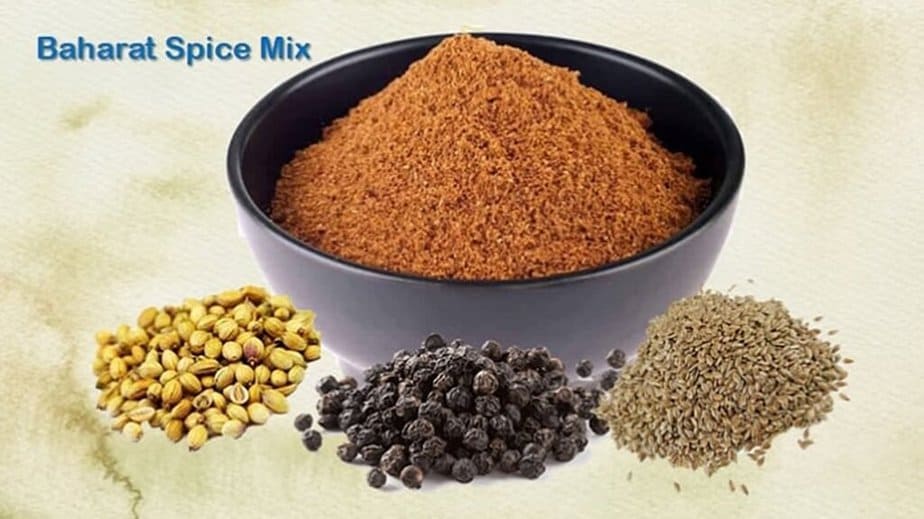There are several types of spice blends specific to the traditional recipes of a particular region and its food culture.
Baharat spice mix is the most popular in the Middle East. Therefore, it is not readily available in the rest of the world.
Middle Eastern food is phenomenal. In fact, it is the spice blends like baharat that make Arab foods so delicious and endearing.
When you are going to prepare a recipe that requires baharat spice mix, and you have it, there is nothing to worry about. You can easily make this spice mix by yourself or use a baharat substitute.
What is Baharat?
The word ‘baharat’ means ‘spice’ in Arabic.
Baharat is a peppery spice mixture very popularly used in Middle Eastern, Turkish, and Greek cuisines.
Adding a little of this spice blend can bring incredible depth and flavor to meat, stews, sauces, soups, vegetables, and others. This spice mixture can also be used as a condiment.
There exist several variants of this spice mix from one region to another with a difference in one or more ingredients included or excluded in it. For example, the Turkish baharat includes mint in the most significant proportion, while Arabian baharat doesn’t have it at all.
A typical recipe for baharat is a mixture of the following finely ground ingredients:
- 4 parts black pepper
- 3 parts coriander seeds
- 3 parts cinnamon
- 3 parts cloves
- 4 parts cumin seeds
- 1 part cardamom pods
- 3 parts nutmeg
- 6 parts paprika
Best Baharat Substitutes
Unless you have a Middle Eastern gourmet store in your area or get it online, it’s challenging to find baharat, especially outside the Arab region.
No problem, even if you don’t have the pre-mixed baharat. Here are the best substitutes for baharat spice mix.
1. DIY Baharat
As there are many variations in baharat depending on the region, the Middle Eastern baharat blend is our consideration here. It typically includes cardamom and paprika, along with cumin and nutmeg. The other key ingredients in it are allspice, coriander, and saffron.
If you notice, most of these ingredients may already be in your kitchen cabinet or can easily be found at a local grocery store near you.
While making this spice blend, you may add or eliminate anyone or two ingredients according to the specific requirement of your recipe and your taste preferences.
Ingredients
- 1 tablespoon black peppercorns
- 1 tablespoon cumin seeds
- 2 teaspoons coriander seeds
- 1 teaspoon whole cloves
- ½ teaspoon cardamom seeds
- 1½ tablespoons paprika
- 1 teaspoon ground cinnamon
- ¼ teaspoon ground nutmeg
Instructions
Roast the ingredients, except cinnamon, nutmeg, and paprika, as whole spices/seeds over medium-high heat for about 4 minutes. While roasting, keep it tossed regularly to prevent scorching. Transfer the roasted ingredients to a bowl and let them completely cool down. Then grind all the ingredients together, including unroasted paprika, nutmeg, and cinnamon, in a coffee or spice grinder till they turn into powder. Store the ground spice mixture in an airtight glass jar.
2. Ras el hanout
The name ‘Ras el hanout’ literally means the head (or king) of the shop. It is a North African spice mixture that usually consists of over a dozen spices in different proportions. The ingredients used in this spice mixture include cinnamon, nutmeg, cardamom, mace, allspice, cumin, clove, dry ginger, chili peppers, sweet and hot paprika, coriander seeds, peppercorn, dry turmeric, and fenugreek.
This spice mixture contains all the ingredients used in baharat and a few more. They both share a similar flavor because of the common ingredients.
The difference between these two spice blends is only noticeable if a significant variation is made in the measure of ingredients used for making them.
You can substitute Ras el hanout for baharat in a 1:1 ratio.
3. Garam masala
Just like the Ras el hanout, the garam masala (popularly used in Indian cooking) contains more or less the same ingredients used in baharat. The flavor profile of baharat is similar to that of garam masala.
The dominant ingredients in garam masala are cloves, cardamom, and coriander.
Garam masala is typically used for adding to cooked foods as you do with the baharat. Both these spice blends are equally hot.
Use the garam masala in your recipes in the same measure as you use baharat.
What is Baharat Used for?
Undoubtedly, baharat is quite a versatile spice mix.
This spice blend is popularly used as a dry rub on almost all types of meat cuts.
Most home chefs use it as an elemental seasoning in stews and soups, giving them a delicious, mild, sweet, and hot punch.
Besides meat recipes, you can use it as a complement to vegetables and seafood. It works very well as a flavoring in salads and vegetable stews.
In the Middle East, baharat is used in the local staple delicacies of pilaf dishes which are rice-based. Also, this spice blend is used in dishes that contain lentils and similar legumes.
With its growing popularity across the world, you’ll find some burger joints in the West using baharat as a seasoning in hamburgers and lamb chops.
The Bottom Line
Baharat is a savory spice blend that is used in both Middle Eastern and Greek cuisines. The word baharat is simply the Arabic word for spice. In the Middle East, it is often used as a condiment that is added to cooked food.
In place of pre-mixed baharat, you can make this spice blend at home. Other close substitutes for baharat are Ras el hanout and garam masala.
Related articles:
- Can I use pumpkin pie spice instead of apple pie spice?
- How do I substitute pumpkin pie spice for individual spices?
- What can I substitute for garam masala?
